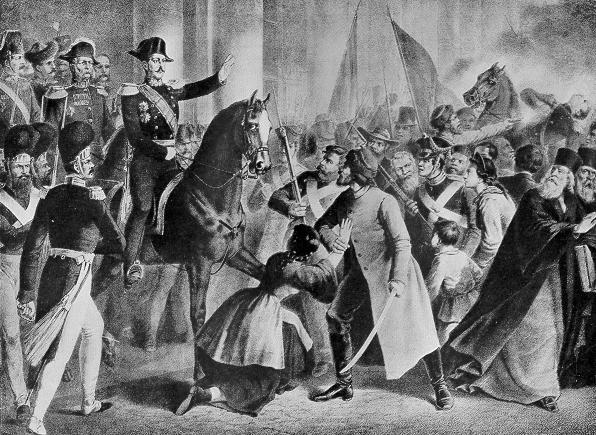The uprising on Senate Square was the result of the penetration of educational ideas from Europe into Russia. The reactionary policy of the tsarist government intensified the tendency toward free thought that arose in the thinking part of society. After the Patriotic War of 1812, the national economy of Russia was in ruin.
However, the government over the several post-war years did not bother to carry out the necessary reforms that would facilitate the fate of the general population. As a result, spontaneous popular uprisings arose throughout the country. They became especially frequent during the famine of 1820-1822. The main demand of the peasants was the abolition of serfdom - a relic of the feudal era, which had long since disappeared in
Western Europe. There were painful problems in the army. Especially hateful to the people was the State Commissioner of Alexander I in this area, Count A. Arakcheev. His activity in creating the so-called
military settlements, where the soldiers themselves had to work in the fields and provide for their own needs, not forgetting the military drill, met fierce resistance from the latter. The tyrannical
rule of Alexander I did not arouse sympathy among liberal-minded nobles who cast an interest in looking at examples of democratic transformations and modernization of society in Europe. Actually, it was the nobles who prepared the uprising on Senate Square.
Secret societies

In the second decade of the 19th century, among liberal-minded aristocrats, an understanding was finally formed that the current reactionary policy of the tsarist government impeded the development of the country and ensured its lagging behind the advanced states of Europe and North America. In 1816, the first secret society arose, called the “Union of Salvation”. It totaled about 30 members, almost all of them were young army officers. The main goals of the illegal community were the abolition of serfdom and the elimination of tsarist autocracy in the country. However, two years later, the conspirators were exposed by the government. The next such organizations were the “Union of Welfare” and the “Southern Society” and “Northern Society” that emerged as a result of its split. These secret clubs had common global goals, but different views on how to achieve them and on the subsequent administrative-territorial and political arrangement of Russia. However, the sudden death of the autocrat in November 1925 prompted the conspirators to a single decision: it is necessary to act without delay already this year - 1825. The uprising on Senate Square was prepared in just two weeks.
Failed coup
The oath of the new Tsar Nicholas I was appointed on December 14. On the same day, the rebels called for an uprising on Senate Square. The main events unfolded in the morning on the day of the royal oath. The troops, led by opposition officers, were to take control of the senators and force them to declare that the tsarist government had been deposed instead of taking the solemn oath of oath.
After that, the participants in the uprising on Senate Square planned to announce a manifesto addressed to the entire Russian people about the revolution that had taken place. However, the banal inconsistency and indecision led to the collapse of all plans. At a decisive moment, it turned out that
Nicholas I had already managed to take the oath to the Senate early in the morning. The decisive actions of the Decembrists could still save the situation. However, at a decisive moment, the chief military leader of the uprising Trubetskoy never appeared on the square, leaving his like-minded people without support. This hitch gave the government the opportunity to seize the situation, gather military forces, surround the conspirators and crush the rebellion on Senate Square.